

| Home | For sale | Site map | Contact information | Guest book | Leuchtpistole menu |
 Markings,
makers and names of Die
Leuchtpistole Markings,
makers and names of Die
Leuchtpistole  |
|---|
|
Markings & makers Walther’s production of the Leuchtpistole ran parallel with the production for the commercial market, exports and production to other state and paramilitary organizations. It is relatively easy to distinguish these from one another by the marking. It is also worth noting that initial production for one organization does not necessarily mean that the flare gun did not end up with the other. There is a wide variety of markings, and sometimes a total lack of them. This is not a complete list of the markings, but the most common markings should be covered. The physical marking on the flare guns varied among the individual manufacturers, so we have to look at one manufacturer at a time. As a general rule all flare guns marked with a code from April 1940 onwards were manufactured for the Wehrmacht. Furthermore, all flare guns marked with a four-digit serial number followed by a lower case letter were manufactured for the Wehrmacht. Four-digit serial numbers not followed by lower case letters can be production for the commercial market. Walther From the start of production the flare gun was marked with the text “Waffenfabrik Walther Zella-Mehlis (Thür.)” over the manufacturer's trademark; a waving banner with the text "WALTHER". Zella-Mehlis is the city of Thuringia where the factory was located before and during the war. The company was "restarted" in Ulm post war. The banner marking was replaced by the code "ac" after April 1940 to prevent the allies from identifying manufacturers and capacities for military production. Commercial production was still marked to the prewar standard, usually without year-marking. In order to distinguish between commercial and military production at Waffenfabrik Walther, one must look at the serial number. The deliveries to Wehrmacht Heer were always marked in "blocks" with a four-digit serial number, for flare guns over serial number 9999 followed by a small letter in the font Fracture (Gothic). 1935 was the first year they dated their flare guns. It is unclear how the numbering sequence was practiced up to this point, but from 1935 they started manufacturing in the "a" block. One known specimen in Duralumin from 1935 has a serial number that is in the “a” block, and is probably from a trial batch that was delivered to Wehrmacht while the production of the steel model still ran at full speed. The production in steel continued in the "a" block into 1936, before the production switched to Duralumin, probably at the transition to the "b" block. The lowest registered serial number in Duralumin in 1936 is "133b". After that production continued with the full manufacturer's marking in the same number series until mid-1940 before they switched to the code "ac". The last registered serial number with the complete factory marking (banner + Waffenfabrik Walther) is in the early "g" block. After this the production was coded with "ac", and it continued to the highest serial number registered in 1940 in the middle of the "h" block. The three following years they change the system of the serial numbering. Walther starts the numbering sequence every year on 1, without any letter. In 1943, the production in Duralumin ends a bit into the "a" block, and the production of the frame and barrel resumes in steel in the same serial number series. The highest registered serial number in steel is 2817a. The production of the flare gun in zinc starts in 1943, and appears to be numbered from the start in a separate series.  At the Walther factory individual parts were marked with the acceptance mark WaA359. Until 1939, the test marks on the right side of the barrel consisted of B / S / U under an imperial crown, as well as "4" in a circle for the caliber and a spoked wheel, believed to symbolize approval of smooth-barrel weapons for the Zella-Mehlis region. The B / U under an imperial crown are repeated on the frame. From 1940 and onwards these are all replaced by an eagle over an upside down heart with a fir tree inside; the civil test approval mark for the region of Zella-Mehlis, Thuringia. The same mark is stamped on both barrel and frame. Waffenfabrik Walther also manufactured the Leuchtpistole for the commercial market or for other organizations. These flare guns initially had a five-digit serial number and later went to a five-digit serial number followed by the capital letter "L". Flare guns from these deliveries may still have ended up with the other military or paramilitary organizations, but they are usually marked with additional Luftwaffe, Polizei or Kriegsmarine markings. A series of flare guns from Walther was also delivered to the Kriegsmarine without manufacturer markings or year of production at all. The latest flare guns of this type manufactured by Waffenfabrik Walther were made of zinc with full pre-war marking (banner), five-digit serial number followed by an "L" and with the last type of wood grip plates. Walther's production for the Wehrmacht was marked the same way throughout the production with the serial number on the barrel just in front of and above the hole for the barrel pin, and on the frame just below the hole for the barrel pin. ERMA-ERFURT The manufacturer Erfurter Maschinenfabrik Berthold Geipel GmbH, Erfurt marked their flare guns with the acronym "ERMA-ERFURT" from the start of production in 1937 and until the middle of 1940 when they switched to their assigned code "ayf".  The serial numbers were constructed the same way as the production at Walther, but in a continuous series from "1" in 1937 to the end of "n" block late in 1943. Production in zinc started in 1943 and was marked in a different series from "1" in the same manner. Individual parts were marked with WaA280. «Commercial» production mostly consisted of deliveries to the police during the pre-war period. These are marked with "ERMA-ERFURT", year of production and a police eagle. Serial numbers delivered to the police are in the first block (0-9999), and regardless of the year it is without a block letter. This makes it highly likely that these were numbered in a separate series. ERMA's standard production was marked with a serial number on the barrel just in front of and above the hole for the barrel pin, and on the frame just below the hole for the barrel pin. In the "L" block in 1943 the serial number on the barrel was moved up to the bottom surface of the octagonal part. The serial number of the barrel on these flare guns can be inspected without disassembling the barrel. Both the barrel and the frame were marked with the military "Beschuss" stamp on the right side, a small eagle with a swastika. Berlin-Lübecker Maschinenfabrik Berlin-Lübecker Maschinenfabrik, Bernhard Berghaus, Lübeck was the only manufacturer who marked his production with the codes from the inter-war period (See the chapter Increased needs and new makers, the "ЯR" mystery, about halfway down the page, for more information about the subject). They were assigned the code "S/237" in 1937 when their flare gun production started, but in 1939 it was simplified to "237". In 1941 this was changed to the new code "duv", according to the directives issued in April 1940. The code was always positioned above the year. In the course of 1943, they changed the marking by first moving the code below the year, and then the code and year were enclosed by a square. There are thus three variants of "duv 43".  The serial numbering was of the standard type, but they followed their own system by starting the numbering sequence from "1" each production year. The flare guns manufactured in zinc from 1942 and 1943 appear to have been numbered in their own series. No commercial production has been identified. Individual parts were marked with the proof mark WaA214. 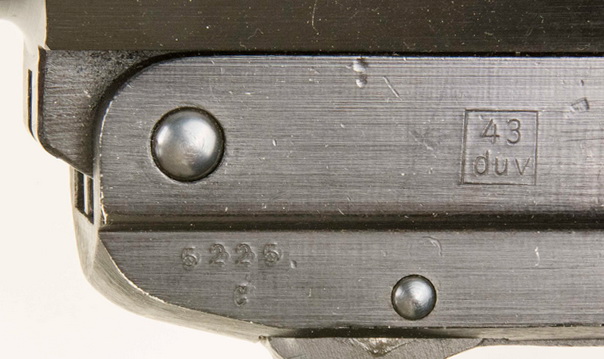 Berlin-Lübecker Maschinenfabrik's production was marked throughout the production period with the serial number on the frame under the hole for the barrel pin. The barrel was never marked with a serial number. Both the barrel and the frame were marked with the military "Beschuss" stamp on the right side, a slightly larger eagle over a swastika. In the name of simplicity... When Fritz Walther constructed the flare gun it was simply called “Leuchtpistole”. However, as time marches on the veil of history has really complicated matters. 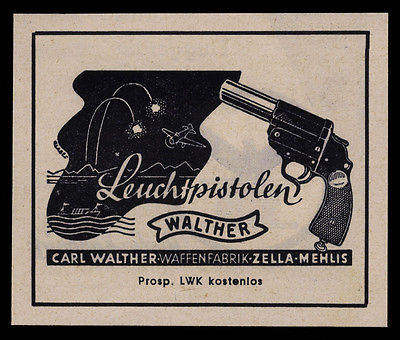 Collectors love to attach names to things and to categorize them, in order to distinguish models or versions from each other when the official name is unknown. The "Hebel" and the "Drückknopf" flare guns are typical collector’s "inventions" As a flare gun for the commercial market it was called “Walther’s Leuchtpistole” to discern it from competitors, but it was also categorized in brochures as a "Signalpistole". 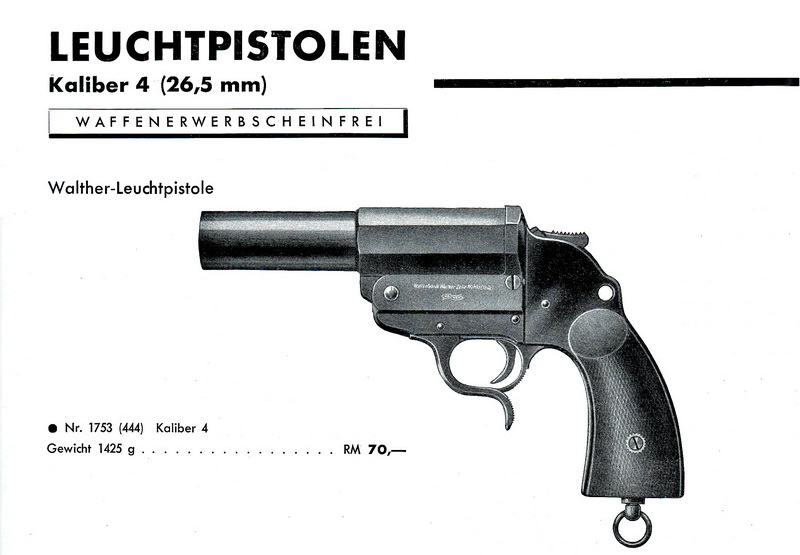 (Picture courtesy of Vidar Andresen) The name "Walther-Leuchtpistole" was printed in commercial brochures and advertisements in the 1930s, at least right up to the Geco catalog from 1937 (picture above). Directly translated it becomes "Light (illuminating) pistol", which refers to the original application area. As the use expanded over the years, it was more and more common to use the "Light pistol" to fire signals. But the word "Signal" was not used by the Wehrmacht to describe the flare gun; it only refers to the ammunition. Reichswehr had little need to distinguish between models after the "Walther-Leuchtpistole" was acquired in the period 1926-1928, so they simply named it "Leuchtpistole", abbreviated "LP". This term was dominant in all military publications until the heir came into use; the "Leuchtpistole 42", abbreviated "LP42". In the new release of H.Dv. 409, published on July 1, 1943, the flare gun was referred to as "Leuchtpistole (Model Walther)", to distinguish between the "old" standardized flare gun and the new LP42. The only case where one needs to distinguish between the new flare gun (Leuchtpistole Model Walther) and the old flare gun (Leuchtpistole Model 1894) is when there is equipment or accessories that is not compatible. In this case, they are referred to as “Leuchtpistole a/A” and “Leuchtpistole n/A”, respectively. “a/A” and “n/A” means old and new version (alter Art and neuer Art). It should also be mentioned that by the outbreak of war, a weapon system was developed which was based on Walther’s Leuchtpistole, the so-called "Leuchtpistole Z" (LP Z) and later "Leuchtpistole 42Z" (LP 42Z). This system will be described in a later article. All "models" of the Walther-Leuchtpistole, with the exception of Leuchtpistole Z, thus have the same designation in the Wehrmacht; "Leuchtpistole" This applies regardless of whether the flare gun has a long barrel, is manufactured in steel, Duralumin or in zinc. One does not distinguish between "editions", since the differences that occur over time are largely due to improvements or simplifications in the production of parts. Post-war collectors in need of cataloging and separating «versions» from each other created all the names of the different versions of this flare gun, even though these "versions" were in reality the same product at different stages of a development that lasted from 1926 to 1943. Examples of fictitious collector terms are "M26", "LP26", "M34", "LP34", "Heer Model 1934", "Kriegsausführung", "Ausführung 1943" and "Zink Signalpistole Model Heer". 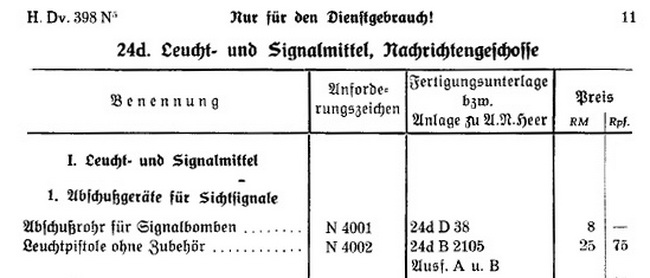 In the Wehrmacht supply system, Walther's flare gun had article number "N4002", and all parts for the flare gun were numbered in the same series (see Accessories for the Leuchtpistole for more details). "4002" is, of course, only a serial number that was used to identify a complete flare gun, but "N" in this context is of interest.  This letter denotes "Nachrichtengerät", communication equipment, in the Wehrmacht supply system catalogue. In other words, the flare gun was not classified as a weapon, or infantry equipment, but as communication equipment. The Luftwaffe appears to have been the only branch of the Wehrmacht that engraved the article supply number (N4002) on the left side of the steel frame on early issues of the long barreled Walther flare gun. The engraved number is "bare metal" in contrast to the rest of the frame that was "blued" at the factory. This clearly indicates that the N4002 marking was applied to the frame post-factory. 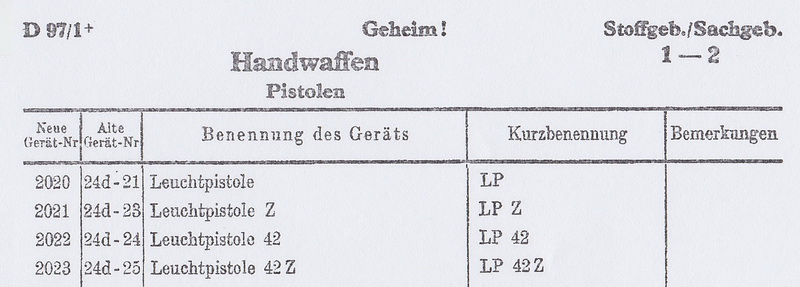 As part of the counter-espionage work, the flare gun was also allocated a "Gerätnummer", which was used in connection with purchases, freight orders, deliveries, etc., mostly between purchasers, manufacturers and suppliers. In July 1943, the Gerätliste contained 4 "variants" of Leuchtpistole, and it is clear that the Wehrmacht only distinguishes between Leuchtpistole and Leuchtpistole 42, with a "Z" model for both main variants. Interestingly enough, the Gerätliste now categorize the Leuchtpistole as a “Handwaffen”. In the Gerät list from April 1945, a last category has been added, in which the production of "Behelfsleuchtpistole", i.e. simplified constructions, has also been officially included. Similar data for this was "2024 - Behelfsleuchtpistole - Beh LP". "Leuchtpistole" also had a code name within the Third Reich administration regime, the not so inventive word "Lebensretter". As a curiosity, it can be mentioned that the flare gun after the war received the SNL number B1001-151602, and later NATO catalog number 1095-25-102-7202. 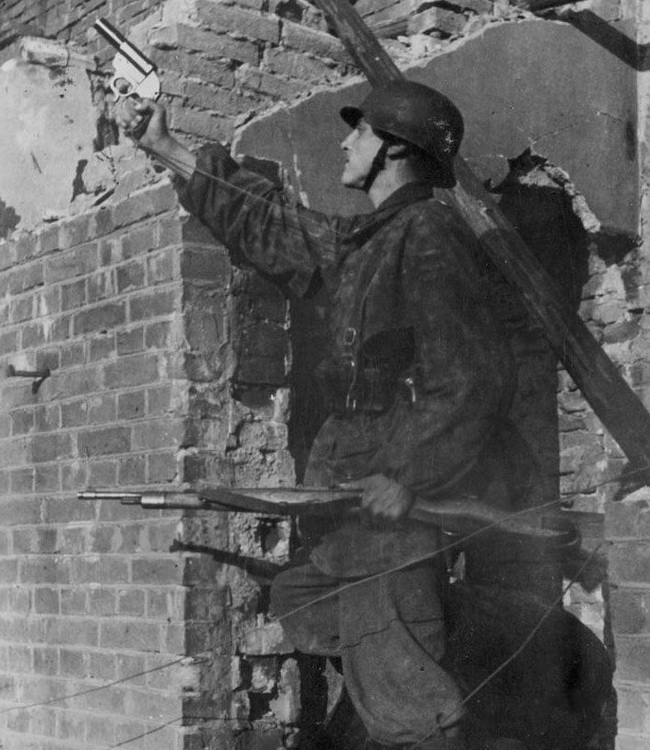 |
| Home | For sale | Site map | Contact information | Guest book | Leuchtpistole menu |